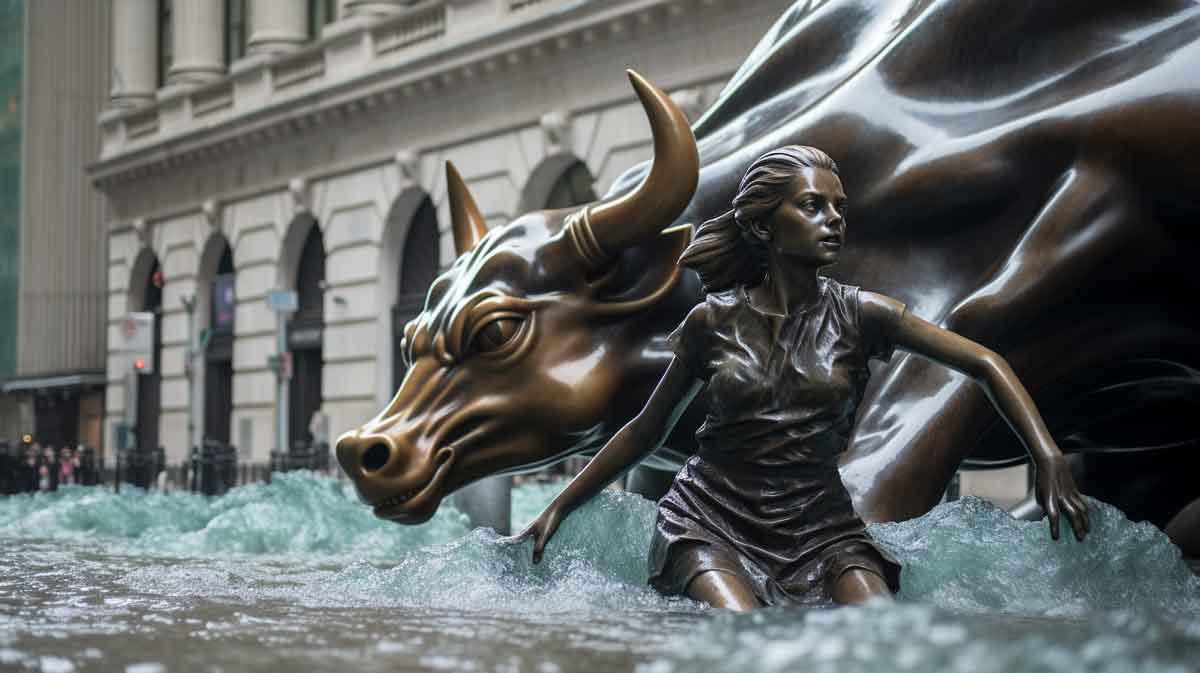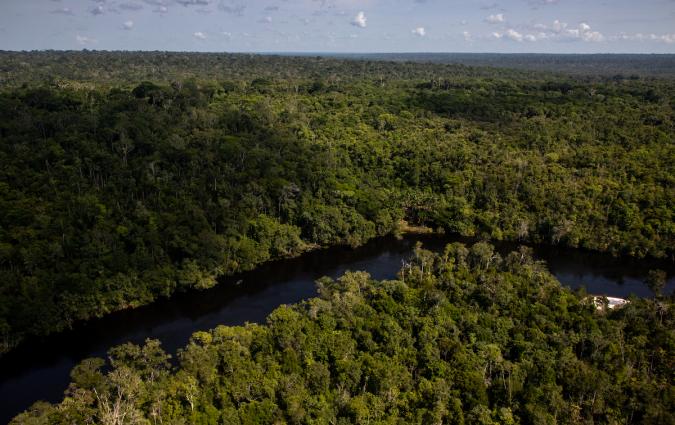In this piece
Five key questions for business journalists navigating sustainability coverage

The Charging Bull and The Fearless Girl statue – Wall Street’s iconic symbols of strength, power and resilience – wade through flood waters in an AI-generated illustration. Credit: Midjourney
In this piece
1. Follow the money or the emissions? | 2. Change individuals or the system? | 3. Focus on now or the future? | 4. Find the problems or solutions? | 5. Be a bystander or a changemaker?Business and financial journalists – traditionally focused on company earnings, economic reports, and central bank policies – now find themselves increasingly covering climate change-related topics as a warming globe threatens to disrupt the stability and prosperity of many companies and industries.
Big corporations are some of the largest contributors to climate change, but they are also the victim of it. Climate stories in the business section can not only prompt wealthy and influential readers to drive substantial changes, but also enable newsrooms to reach a wider audience beyond the traditional business news reader.
In recent years, many mainstream business media outlets have established dedicated teams, focused on sustainability stories that are driven by rising interest from both their audiences and reporters. These teams usually have a lot of freedom on the stories they want to pursue, and rely heavily on partnerships across the newsroom.
Major coverage areas include key industries helping to facilitate the clean-energy transition, carbon accounting and its credibility, and the so-called sustainable investing that aims to channel more capital to the greener industries and away from the brown ones.
Since sustainability is a new beat that simply didn’t exist a few years ago, these journalists face many challenges: they often work on small teams with limited resources, and may find it hard to resonate with the audience, identify greenwashing, or find trustworthy data.
For my Journalism Fellowship project, I spoke with nine journalists from dedicated sustainability teams at major business media outlets. Below are some of the key questions that repeatedly emerged during the conversations. You can read the full project in the PDF below.
1. Follow the money or the emissions?
The phrase "follow the money" has long guided business journalists as they pursue stories based on how much money – whether revenue or stock value – is involved. But in the face of the climate crisis, focusing solely on financial aspects may overlook crucial corners of the economy that play an important role in climate change. “Follow the emissions” should be the new mantra, said Ben Elgin, investigative reporter at Bloomberg Green.
While industries like mining, building, and transportation receive much less media attention than tech giants, they consume significant amounts of energy and are some of the largest contributors to carbon emissions. And yet consumer-facing companies often get a lot of coverage for their sustainability plans despite having a smaller carbon footprint to begin with. To address the larger threats at hand, journalists should put more focus on industries with great importance to the global carbon budget.
2. Change individuals or the system?
Personal responsibility in reducing carbon footprints has been widely promoted in the media over the past decades. But climate activists warn that such rhetoric could be used to distract public attention from the much bigger, systematic problems that need addressing in the economy, such as energy transition.
It is important to remember that corporations and industries – rather than individuals – are the much bigger polluters that should be scrutinised more. “As a journalist, my job right now is to hold business and government to account because they have more power to make the biggest changes,” said Lameez Omarjee, sustainability reporter at News24 Business.
Of course, journalists can still explore the impact of individual actions, and the media should empower consumers by providing relevant information that helps them make informed decisions. By balancing coverage of systemic issues and consumer-level actions, journalists can encourage a collective effort to address climate change.
3. Focus on now or the future?
Besides recording what’s happened in the past, business and financial journalists often need to look beyond the present and identify important trends that may have a large impact on the future. When it comes to sustainability coverage, that means closely watching emerging technologies and potential solutions – especially in sectors that have not yet found a pathway of decarbonisation.
Since covering future-oriented topics can involve a lot of speculation, journalists must exercise caution and gather credible perspectives to present a balanced view, said Lora Kolodny, climate tech reporter at CNBC. But they should not be afraid of getting it wrong. Transparency about mistakes and a willingness to reflect and learn can also help build relationships and trust with the audience.
4. Find the problems or solutions?
While holding those in power accountable is crucial, sustainability coverage should not solely focus on exposing problems and wrongdoings. By showcasing potential solutions and innovations, journalists can foster a sense of hope and encourage positive action from the audience.
“What we try to do with our coverage is to be constructive and point out ways in which things could be done better and the interesting debates about how to do that, rather than trying to find out who the evil people are,” said Simon Mundy, editor of Moral Money at the Financial Times.
Journalists also play a vital role in evaluating the viability of potential solutions to ensure that attention and resources are channelled towards the more effective strategies. By doing so, journalists could help shape public discourse and drive progress in the fight against climate change.
5. Be a bystander or a changemaker?
Journalists have traditionally strived for objectivity in their reporting, which means to remove any opinion or personal stand from the stories. But when it comes to climate-related topics, some argue that journalists should be stauncher in drawing attention to the urgency of the crisis and inspire more people to take action.
While most journalists don’t view themselves as climate advocates, they often find it challenging to balance the professional expectation to stay on the sidelines and their personal responsibility to fight climate change as a member of society.
Striving for impartiality should not lead to a “stenographer problem” where journalists simply relay information without providing context. Rather than getting caught up in conflicting arguments, journalists should be more assertive in their reporting by doing thorough research and presenting facts and data, said Amrith Ramkumar, climate finance reporter at the Wall Street Journal.




